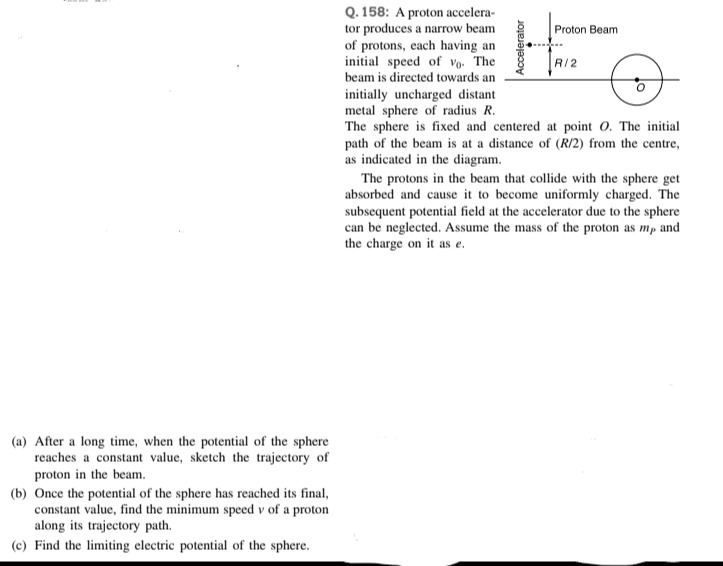Question
Question: A proton accelerator produces a narrow beam of protons, each having an initial speed of $v_0$. The b...
A proton accelerator produces a narrow beam of protons, each having an initial speed of v0. The beam is directed towards an initially uncharged distant metal sphere of radius R. The sphere is fixed and centered at point O. The initial path of the beam is at a distance of (R/2) from the centre, as indicated in the diagram. The protons in the beam that collide with the sphere get absorbed and cause it to become uniformly charged. The subsequent potential field at the accelerator due to the sphere can be neglected. Assume the mass of the proton as mp and the charge on it as e.
(a) After a long time, when the potential of the sphere reaches a constant value, sketch the trajectory of proton in the beam.
(b) Once the potential of the sphere has reached its final, constant value, find the minimum speed v of a proton along its trajectory path.
(c) Find the limiting electric potential of the sphere.

v_0/2
Solution
The problem describes the interaction of a proton beam with a metal sphere, leading to the sphere becoming charged. We analyze the motion of protons under the influence of the charged sphere.
(a) After a long time, the potential of the sphere reaches a constant value. This occurs when the electric potential of the sphere is high enough to repel the incoming protons such that they no longer collide with the sphere. The force on a proton due to the positively charged sphere is repulsive and radial. The initial path of the beam is a straight line with an impact parameter of R/2. Due to the repulsive force, the trajectory of the proton will be deflected away from the sphere. The trajectory of a charged particle in a central repulsive potential is a hyperbola. When the potential reaches its limiting value, the protons with initial speed v0 and impact parameter R/2 are just unable to reach the sphere. The limiting case for collision is when the trajectory is tangent to the surface of the sphere. Sketch of the trajectory: The trajectory is a hyperbola with the center of the sphere at one of the foci. The initial asymptote is a line parallel to the initial velocity vector at a distance R/2 from the line passing through the center and parallel to the initial velocity. The trajectory bends away from the sphere. In the limiting case, the hyperbola is tangent to the sphere at the point of closest approach.
(b) Once the potential of the sphere has reached its final, constant value, the protons with initial speed v0 and impact parameter R/2 just graze the sphere. The minimum speed of a proton along its trajectory occurs at the point of closest approach to the center of the sphere. In the limiting case, this point is on the surface of the sphere, at a distance R from the center. Let vg be the speed at this point. We use conservation of energy and angular momentum. Initial energy (far away from the sphere, V=0): Ei=21mpv02. Initial angular momentum about the center of the sphere: Li=mpv0(R/2), where R/2 is the impact parameter. At the point of closest approach on the surface of the sphere (r=R), let the speed be vg. The velocity vector is perpendicular to the radius vector at this point (tangent to the sphere). Energy at this point: Ef=21mpvg2+eVL, where VL is the limiting potential of the sphere. Angular momentum at this point: Lf=mpvgR. By conservation of angular momentum: Li=Lf⟹mpv0(R/2)=mpvgR⟹vg=v0/2. By conservation of energy: Ei=Ef⟹21mpv02=21mpvg2+eVL. Substitute vg=v0/2: 21mpv02=21mp(v0/2)2+eVL. 21mpv02=81mpv02+eVL. eVL=21mpv02−81mpv02=83mpv02. The minimum speed along the trajectory is the speed at the point of closest approach, which is vg=v0/2.
(c) The limiting electric potential of the sphere is VL. From the energy conservation equation in part (b), we found: eVL=83mpv02. VL=8e3mpv02.
